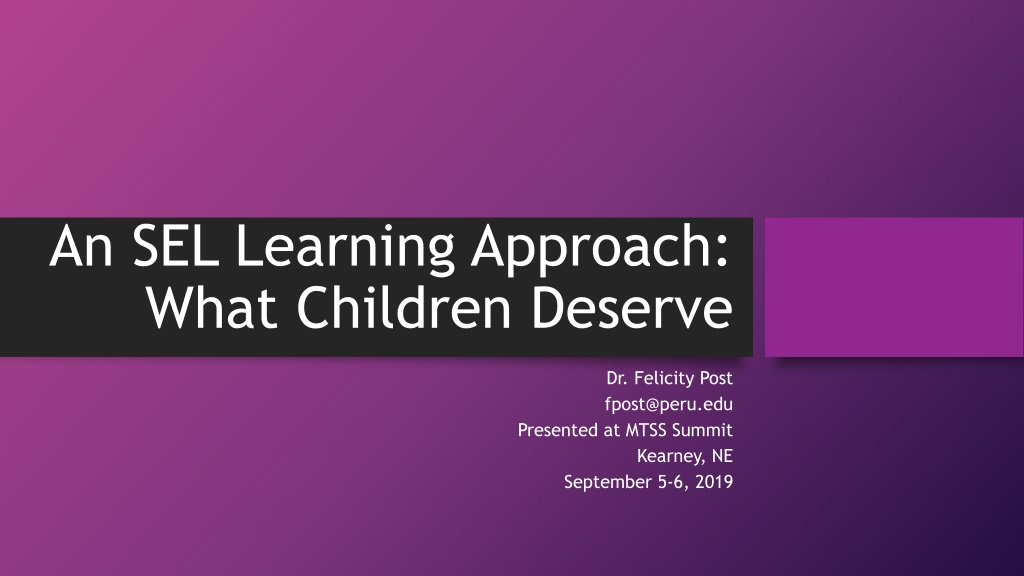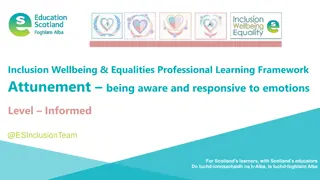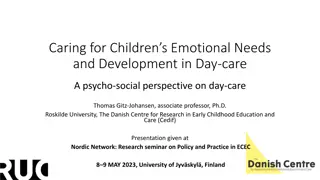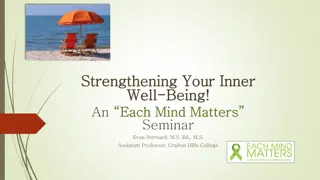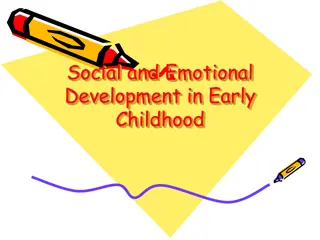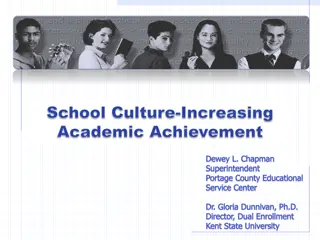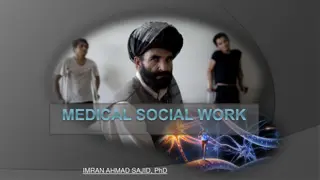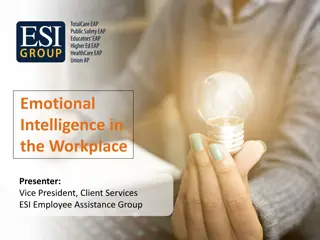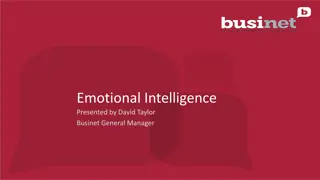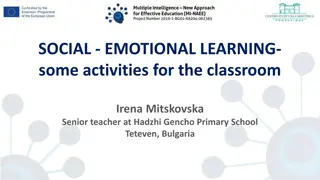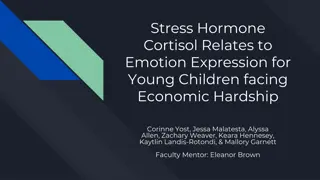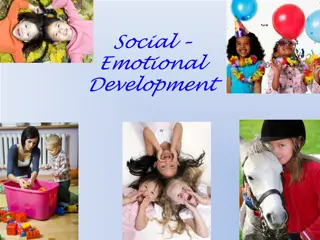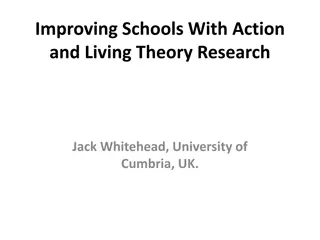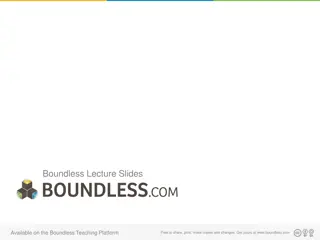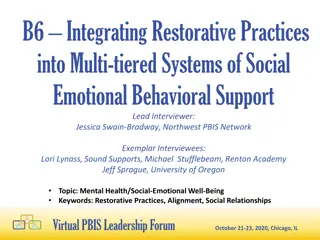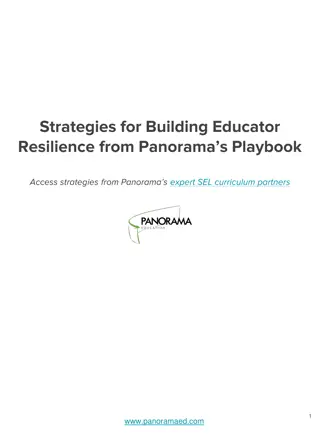Understanding Social-Emotional Learning: What Educators Should Know
Explore the key components of Social-Emotional Learning (SEL) and its importance in developing meaningful relationships with students. Discover the five core SEL competencies and learn how educators can support children in managing emotions, building positive relationships, and making responsible decisions. Gain insights into teaching SEL skills effectively in diverse learning environments.
Download Presentation

Please find below an Image/Link to download the presentation.
The content on the website is provided AS IS for your information and personal use only. It may not be sold, licensed, or shared on other websites without obtaining consent from the author. Download presentation by click this link. If you encounter any issues during the download, it is possible that the publisher has removed the file from their server.
E N D
Presentation Transcript
An SEL Learning Approach: What Children Deserve Dr. Felicity Post fpost@peru.edu Presented at MTSS Summit Kearney, NE September 5-6, 2019
All educators believe that children should be held accountable for their behavior and supported as they learn from their mistakes, but what does that look like in practice? Building meaningful relationships with students is the foundation for helping them develop social-emotional competency and creating a positive school culture in which all students have the opportunity to thrive. During this session, a discussion of what constitutes a meaningful relationship as well as accountability and support when working with students in a classroom setting using an SEL approach will occur.
Objectives As a result of attending this session, learners will gain critical insight into the various facets of social emotional learning. discuss what constitutes a meaningful relationship. determine accountability and support using an SEL lens.
What is Social Emotional Learning (SEL)? The process through which children and adults understand and manage emotions, set and achieve positive goals, feel and show empathy for others, establish and maintain positive relationships, and make responsible decisions. -CASEL
5 SEL Competencies 1. Self-awareness: Know your strengths and limitations, with a well-grounded sense of confidence, optimism, and a growth mindset. 2. Self-management: Effectively manage stress, control impulses, and motivate yourself to set and achieve goals. 3. Social awareness: Understand the perspectives of others and empathize with them, including those from diverse backgrounds and cultures. 4. Relationship skills: Communicate clearly, listen well, cooperate with others, resist inappropriate social pressure, negotiate conflict constructively, and seek and offer help when needed. 5. Responsible decision-making: Make constructive choices about personal behavior and social interactions based on ethical standards, safety, and social norms. CASEL
SEL Competencies Must be explicitly taught 1. Teachers need to build an inclusive and welcoming classroom community 2. Behavioral skills can be taught with the gradual release of responsibility model: modeling, guided practice, and independent practice. 3. Effective SEL targets children s learning across a variety of settings: classroom, schoolwide, and at home
SEL Often surface level implementation Not effective Morning meetings are not enough SEL competencies are not something we are born with. They are learned!!! Discuss SOAR SEL Continuum https://www.responsiveclassroom.org/soar-schools/
Why SEL? When students develop social-emotional competencies, they are more capable of seeking help when needed, managing their own emotions, and problem-solving difficult situations (Romasz, Kantor, & Elias, 2004). These results were consistent across grade level (elementary, middle, and high schools); location (urban, rural, and suburban); and school type (schools serving ethnically and racially diverse student populations). (Merrell & Gueldner, 2010)
SEL Can Be Taught Using Free-standing lessons designed to enhance students social and emotional competence explicitly. Teaching practices such as cooperative learning and project-based learning, which promote SEL. Integration of SEL and academic curriculum such as language arts, math, social studies, or health. Organizational strategies that promote SEL as a schoolwide initiative that creates a climate and culture conducive to learning.
Effective SEL Approaches Are: SAFE: Sequenced: Connected and coordinated activities to foster skills development. Active: Active forms of learning to help students master new skills and attitudes. Focused: A component that emphasizes developing personal and social skills. Explicit: Targeting specific social and emotional skills.
The Truth Worth Telling Define competency There is no perfect teacher, no perfect school leader, no perfect school. The only perfect thing we can do is be willing to revise what we do to make it better. Hindsight affords us a new path and new ways of being, not only for ourselves but for other educators.
Chances- Harmful or Helpful? Pros vs. cons Discuss What messages do we send? Do we tolerate or do we teach? What are the limits of the school and when are they reached ? Who determines this decision?
A Common Response When a student misbehaves, what are the typical responses displayed by educators? Which responses would you label as effective? Ineffective? Why? Do the responses build or hinder relationship building?
Transactional Theory It is easier to be kind to a person when he or she treats you kindly. Researchers have found that teachers develop closer relationships with students who are more mature and intelligent. Conversely, they develop more distant or conflictual relationships with children who display problem behaviors, such as anger and hyperactivity. Why is this a problem considering today s population and need?
Transactional Theory your relationships with students impact their performance. It is very important to note that the relationships you form with students are predicative of the students subsequent relationships with teachers. Positive leads to positive and negative to negative. Think of your personal experiences. Where do you fall? Think of parents and their past experiences.
Negative Momentum Think of your toughest student. Think of their experiences.
Nail it! Make a list of the two most difficult students in your class. Write down five personal pieces of information you know about each one. What you write cannot be in relation to how they perform at school. Good relationships with others means you know lots about them.
Think About It! If you don t know who your students are, you can t teach them. Not new insight but never emphasized enough. Why do we do more for those we know and love than strangers? Trusting relationships allow for achievable and safe learning experiences where children practice communicating, facing challenges, and experiencing and regulating emotions.
The Importance of Relationships Positive, supportive relationships with children help them develop socially and emotionally and enable you to effectively manage your classroom. Children spend an average of thirty-five hours a week, ten months out of the year, with school-based adults-so positive relationships with teachers and school staff are critical for healthy development. The closeness of a relationships is defined not only by what we know about each other but also by how we respond to one another.
How to Build More Positive Teacher-Student Relationships 1. Learn About Your Students Lives Outside of School a) Family survey b) Differences do not matter
How to Build More Positive Teacher-Student Relationships 2. Use What You Learn About Students to Grow a Connection How do you make friends?
How to Build More Positive Teacher-Student Relationships 3. Show Children That You Will Keep Them Safe Few things are more detrimental than not looking out for emotional or physical well-being. Expect kindness and mean it! Do not pretend you didn t hear or see it! What do we do as adults that are detrimental to the relationships we develop with students? Do we typically close the loop ? What do we do instead?
How to Build More Positive Teacher-Student Relationships 4. Show Students Who Are Having a Hard Time That You Care and Are Available Check in-put it on your calendar Chose someone who is struggling- make an effort to talk to them each day to let them know you notice them Be consistent
How to Build More Positive Teacher-Student Relationships 5. Spend Nontraditional Academic Time or Nonacademic Time with Students Be intentional Eat lunch with students Put student in your group, not parent volunteer These efforts aren t a reward for good students behavior and should not be withheld because of misbehavior. Non-contingent upon behavior How are you intentional?
How to Build More Positive Teacher-Student Relationships 6. Validate Their Feelings Feelings aren t wrong, even if you don t share them. Show empathy This shows kids that I get you .
How to Build More Positive Teacher-Student Relationships 7. Speak with Positivity and Compassion Teaching is the one job where you have to find something to like about all of your students. Tell them. Everyone has competencies even if they aren t the ones you want them to have. A positive relationship does not mean an easy one. Result of commitment and work. Remind us that we do not have to be perfect. Grace, not perfection. A bridge that helps us over difficulty Truth: Life can be hard and every human being is flawed.
Do It! Describe your most positive relationship. Surround yourself with the people who bring out the best in you. Students do not have that choice with teachers. They need teachers to commit to a positive relationship!
Strengths What strengths do you bring to the table when working with students? How will each of these strengths help you to develop relationships with students/families/teachers?
Bad Momentum In the state of being overwhelmed, the likelihood that we will make a poor decision becomes high-especially when it comes to classroom management. To avoid the pull of that bad momentum, we need to be anchored by understandings and practices, so that even in the most difficult times, we can act in ways that redirect misbehaving students onto a more positive path. What does this mean? What are our anchors ?
Limits soft limits - A caring teacher who had rules but didn t enforce them. hard limits - No flexibility What kind of limits do students need? Firm Kind Consistent You must consider what your instruction and response communicates with your students. What does it mean to care about your students? What do we do for people we care about?
Setting Boundaries 1. Prioritize relationships with the most challenging students. You cannot positively manage a challenging class you aren t connected with. 2. Share goals and purposes of work with the whole class. EXPECT the directions to be followed. Do NOT ask them to follow! If you ask students to do something, they have the option to say no ! 3. Provide students an opportunity and choice to practice.
Boundaries Two Essential Facts No one deserves eternal leadership with unquestioning followers- leadership must be earned. Human beings challenge their leaders- be it their parents, teachers, principals, or president. I know a challenge is coming every day, no big deal. I m ready for it Remain gentle but firm to keep students safe and productive True leaders who have mastered the art of setting boundaries. Thoughtful readiness.
Reasons Given for Not Establishing Boundaries What do you think they are? Behind each reason is a fear. It s mean. .I want the kids to like me. It s not my personality. I haven t done this before. They can t. I am intimidated and afraid to fail.
Think About It Daily actions accumulate over time into expectations for how we behave and how we respond to each other when there are problems. Positive and negative We want students to challenge us. It is part of growing. If we expect student misbehavior or difficulty, we are in a stance of thoughtful readiness. Expecting students to behave at ALL times is not how the world works!
Are you Realistic? Do it: Think about one ongoing difficult relationship you have. What are the behaviors of that person that make you frustrated/disappointed? What do you wish for instead? Are they tempered by reality? What do you do to maintain the negative momentum in this relationship? What are some things you wish you could do but can t yet? Are these expected of you? Do you expect good AND bad behavior from people in your life? Too high of expectations can cause resentful and angry feelings toward another person.
Grow We don t choose the individuals who come into our classroom. Students do not choose their teachers. There will be personalities in your classroom who are antithetical to your own. Learning to connect to those students, despite the differences, is the growing required of teaching!!! SEL!!! We want efficacy- the capacity or power to reach a desired effect or outcome. Efficacy breeds efficacy. The more you recognize your capacity to get the results you want, the more you are willing to try out that power in new situations. Same for students!
The Cause for Misbehavior Matters Some behavior we are inclined to label misbehavior may be developmentally and/or culturally appropriate. Behavior needs to be interpreted in culturally responsive ways. So many times, we think children are misbehaving, when really what they are doing is being six or being eleven. How do we determine the difference between typical developmental behavior and misbehavior? We must know what is developmentally appropriate in order to manage our classroom and in making decisions about how to support students in terms of SEL competencies.
Expected Behavior Must Be Taught Effective teachers are proactive! Routines and rules should be explicitly taught AND practiced. Before a task is begun, teachers should remind students about the expectations Provide positive reinforcement when students meet your expectations. Praise should be sincerely delivered! 4 to 1 ration of praise to reprimand
Remember We are looking for improvement over time, not a completely different child next week. Don t expect a cured student in a week: you will be disappointed and student will feel incompetent.
Emotional objectivity tough urban school, tough student We make assumptions Which assumptions do we make? Reality- just like all other children Learn from instruction that is clear and specific Learn from instruction that is adjusted to meet their needs and interests Learn best when they have choices Learn best when they understand the boundaries Learn best when kept safe
Emotional Objectivity Think about the outcomes you want for your students The issue, the problem, the interaction, is a professional one in which the teacher must focus on adjusting the student s behavior. Single most important thing to keep in mind when things get heated Things get personal- me vs. them Behavior is NEVER fixed Behavior can ALWAYS change Tagline- Do you think you are in trouble? You are not in trouble. But your behavior needs to change. Diffuses you vs. me
How to Communicate Emotional Objectivity What kind of person do you want as a leader? Uncertainty and anxiety or anger and frustration Leads to students not feeling safe Will mirror those emotions Teachers must project safety and confidence, even when they aren t feeling it! Fake it until you make it!
Thoughts Even when we are proactive and emotionally supportive, children misbehave. This is perfectly natural. There is more than one good way to be a teacher and more than one good way to respond to behavioral issues. Too often our responses are based on what a child s behavior is rather than why he/she may be acting the way he/she does. When we limit our response to behavior, we follow the path taken by our criminal justice system: we punish without understanding. Knowing the reasons children misbehave can make our responses more reasonable and caring.
A Final Thought When we normalize that response through institution-wide expectations that some students will misbehave; that s not out problem and some students won t learn; that s not our problem, we are building a tiered society- the ones who belong and the outsiders. Many children come into our classroom as outsiders, but our response should not be to label them; instead, we must ask ourselves, how can we invite them in? -Cassetta & Sawyer
References Cassetta, G. & Sawyer, B. (2015). Classroom management matters: The social-emotional learning approach children deserve. Portsmouth, NH: Heinemann.
Questions? Dr. Felicity Post fpost@peru.edu
